Many homeowners overlook hidden humidity issues that cause unseen mold, persistent odors, and discomfort, even without visible dampness. Poor air circulation traps moisture, leading to mold growth behind furniture and inside closets. To fix this, monitor humidity levels with a hygrometer, improve ventilation, use dehumidifiers properly, and seal leaks. Natural methods like houseplants and opening windows also help. Keep exploring to uncover more ways to keep your home safe and comfortable from hidden moisture problems.
Key Takeaways
- Hidden moisture sources like leaks and condensation often cause persistent humidity issues overlooked in regular maintenance.
- Poor air circulation traps humid air, leading to mold growth and indoor discomfort, even without visible dampness.
- Using natural methods like ventilation, houseplants, and moisture-absorbing materials can effectively reduce indoor humidity.
- Properly selected and maintained dehumidifiers tailored to room size are essential for controlling excess moisture.
- Persistent humidity problems require professional assessment to identify hidden leaks, improve ventilation, and prevent long-term damage.
Recognizing the Hidden Signs of Excess Humidity
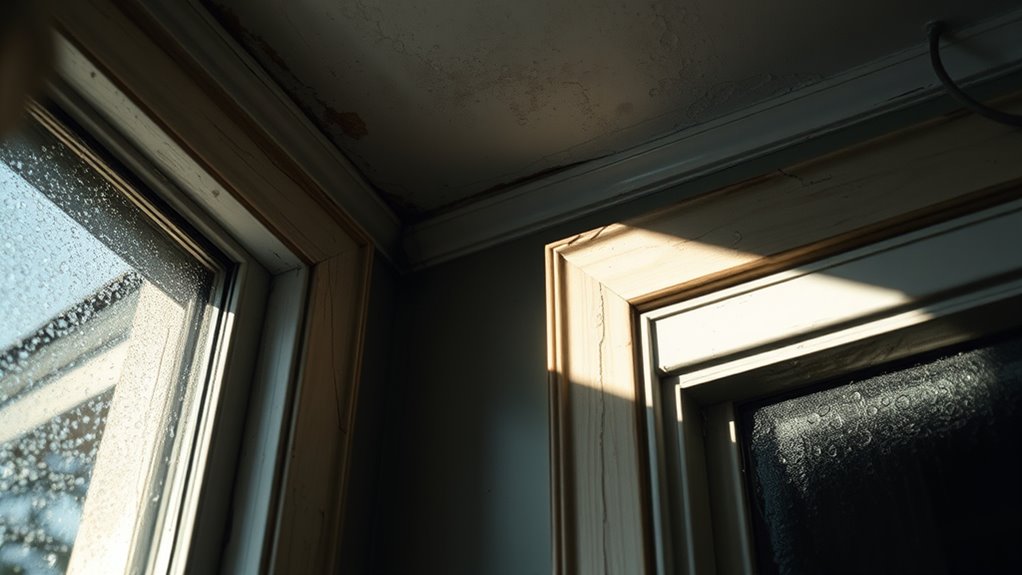
Excess humidity often hides behind subtle signs that can easily go unnoticed. You might notice a persistent musty smell lingering in your home, even when nothing seems damp. Look for condensation on windows and mirrors, especially in the mornings, which signals excess moisture in the air. Discoloration or peeling paint and wallpaper can also be clues that humidity levels are too high. You may feel that your space feels damp or clammy, and your skin might be consistently sticky or sweaty. Mold growth in hidden areas like behind furniture or inside closets is another red flag. These signs aren’t always obvious but indicate that moisture is building up, making your environment uncomfortable and potentially damaging your home. Recognizing these early signs helps you address humidity before it worsens.
The Impact of Poor Air Circulation on Home Comfort

Poor air circulation can substantially reduce your home’s comfort by trapping stale, humid air indoors. When air isn’t moving freely, humidity levels rise, making your space feel stuffy and damp. This can lead to discomfort, stuffy noses, and even mold growth. Poor circulation also prevents fresh air from replacing indoor air, exacerbating the humidity problem. To improve airflow, consider:
- Using exhaust fans in kitchens and bathrooms
- Opening windows regularly to promote cross-ventilation
- Installing ceiling fans to circulate air evenly
These steps help reduce humidity buildup and create a more breathable environment. Better air movement not only boosts comfort but also supports healthier indoor conditions by preventing mold and musty odors. Additionally, understanding how air circulation impacts indoor humidity levels can guide you in choosing the most effective solutions. Improving circulation is a simple, effective way to enhance your home’s overall comfort.
Common Myths About Humidity Control Debunked

Many people believe that simply turning on a dehumidifier or opening a window will instantly solve humidity issues. While these actions can help, they aren’t magic solutions. Relying solely on a dehumidifier might not reduce humidity enough if your home’s moisture sources aren’t addressed. Similarly, opening windows isn’t always effective, especially in humid or polluted environments. Some think that lower humidity always means better air quality, but excessively dry air can cause discomfort and health problems. Others believe that humidity control is only necessary during summer, yet indoor moisture levels can be problematic year-round. Debunking these myths is essential so you understand that effective humidity management requires a thorough approach, including proper equipment, ventilation, and addressing moisture sources. Additionally, understanding the personality traits of individuals involved in the process can influence how effectively humidity issues are managed.
Simple Ways to Measure and Monitor Indoor Moisture Levels
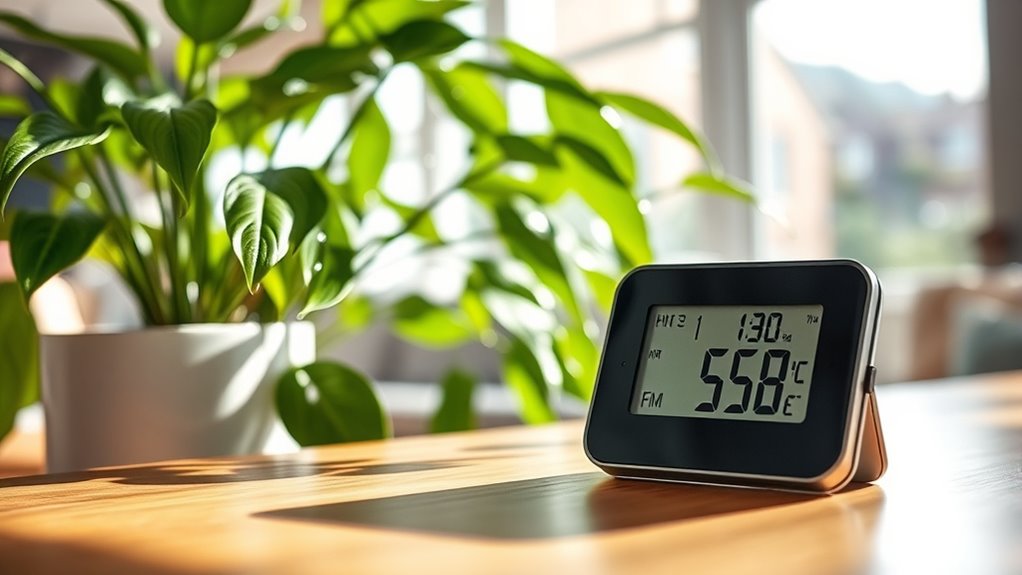
Measuring and monitoring indoor moisture levels is essential for maintaining a healthy and comfortable environment. By keeping track of humidity, you can prevent issues like mold growth and discomfort. A simple way to start is by using a hygrometer, which provides quick and accurate readings of your indoor humidity. Place it in common living areas for the best results. Regularly assessing humidity levels can also help you identify problem areas that may require additional ventilation or moisture control measures.
Monitoring indoor moisture with a hygrometer helps prevent mold and creates a comfortable home environment.
Remember these key points:
- Choose a digital hygrometer for consistent, real-time data.
- Check readings regularly, especially during seasonal changes.
- Keep a log to observe trends and identify problem areas.
Monitoring your indoor moisture levels helps you take proactive steps to maintain ideal humidity, ensuring your home stays healthy and cozy. Staying aware of these levels is your first step toward effective humidity control.
Effective Strategies for Reducing Excess Moisture
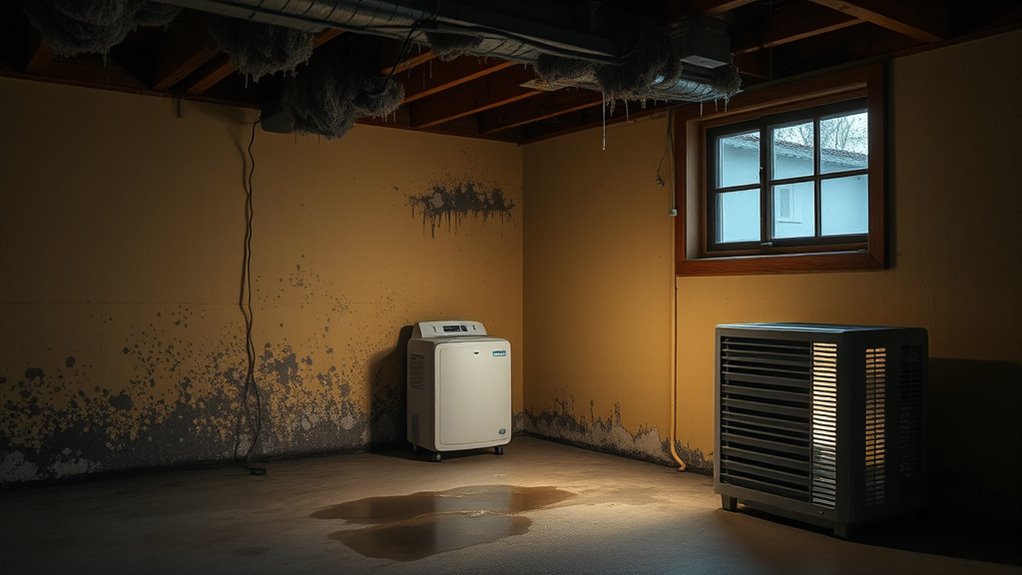
You can cut down excess moisture by improving your ventilation and making sure air flows freely. Using dehumidifiers correctly helps remove humidity from the air, keeping your space dry. Don’t forget to seal indoor leaks, which can let moist air in and make humidity worse. Practicing mindful decluttering can also prevent moisture buildup by reducing clutter that traps dampness.
Improve Ventilation Systems
Improving your ventilation system is one of the most effective ways to reduce excess moisture and prevent humidity problems. Proper airflow helps remove damp air and brings in fresh air, reducing indoor humidity levels. To optimize your system, consider these strategies:
- Install exhaust fans in kitchens and bathrooms to vent humidity directly outside
- Ensure vents and ducts are clear and functioning correctly
- Use programmable ventilation systems to maintain consistent airflow
- Incorporate natural materials and cozy textiles to help absorb excess moisture and contribute to a balanced indoor environment
Good ventilation not only lowers moisture but also prevents mold growth and structural damage. Regularly check and maintain vents, filters, and fans to keep them working efficiently. Remember, effective airflow is key to controlling humidity and creating a healthier indoor environment. Proper ventilation acts as your first line of defense against excess moisture buildup.
Use Dehumidifiers Effectively
Dehumidifiers are essential tools for controlling indoor humidity, especially in areas prone to dampness. To use them effectively, place the unit in the most humid part of your space, such as a basement or bathroom. Keep doors and windows closed when running the dehumidifier to maximize efficiency. Set the humidity level between 30-50%, which helps prevent mold growth and reduces discomfort. Regularly empty the water tank or connect a drain hose for continuous operation. Clean filters monthly to ensure peak performance. Use the dehumidifier consistently during humid seasons or when moisture levels rise. Monitoring humidity with a hygrometer helps you maintain the ideal range. With proper placement, maintenance, and monitoring, your dehumidifier will substantially improve indoor air quality.
Seal Indoor Leaks
Sealing indoor leaks is a highly effective way to reduce excess moisture and prevent indoor humidity problems. By stopping drafts and leaks, you keep humid air from entering or escaping, helping to maintain a balanced indoor environment. Focus on common leak sources like gaps around windows, doors, and utility penetrations. Proper sealing can also improve energy efficiency. To get started, consider these strategies:
- Use weatherstripping around doors and windows
- Seal gaps with caulk or foam around pipes and vents
- Inspect and repair any cracks in walls or foundation
- Incorporate mindfulness techniques to stay attentive to potential leak points during home inspections, ensuring a more thorough sealing process.
Addressing these leaks minimizes moisture intrusion and helps your home stay dry and comfortable. Regularly checking and sealing leaks is a simple, cost-effective step to control indoor humidity and prevent mold growth.
How to Choose the Right Dehumidifier for Your Space

Choosing the right dehumidifier begins with understanding the size of your space and how much moisture it typically contains. Measure the room’s square footage and consider its purpose—basements, bathrooms, or living rooms all have different humidity levels. Next, look at the dehumidifier’s capacity, usually measured in pints of moisture removed per day. For smaller rooms, a unit with a lower pint capacity suffices, while larger or damp areas need higher capacity models. Also, check features like adjustable humidity controls, automatic shutoff, and energy efficiency to match your needs. Consider the noise level if the unit will be in a bedroom or living space. Picking the right model guarantees effective moisture control without wasting energy or space. Monitoring vape juice shelf life or proper storage conditions can help prevent issues caused by excess humidity and spoilage.
Natural Methods to Balance Humidity Without Equipment
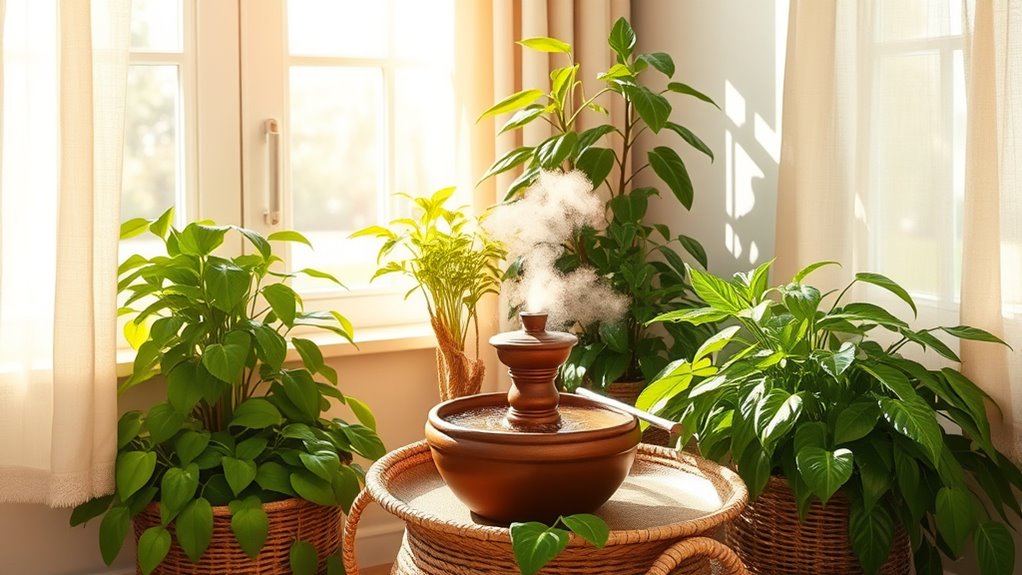
If you want to balance humidity levels naturally, there are simple methods you can try before turning to equipment. First, use houseplants that absorb moisture and release oxygen, helping stabilize humidity. Second, keep windows open when weather permits to allow fresh air to circulate and reduce excess moisture. Third, place bowls of salt or charcoal in problem areas—they naturally absorb humidity without chemicals. You can also control indoor moisture by drying clothes outside or using a fan to increase air movement. Additionally, air circulation techniques such as using ceiling fans can help distribute humidity evenly throughout your space. These natural strategies work well for small issues and are eco-friendly solutions. Remember, maintaining a consistent indoor environment helps prevent extreme humidity, making your space more comfortable and healthier without relying solely on mechanical devices.
The Role of Ventilation and Air Flow in Humidity Management
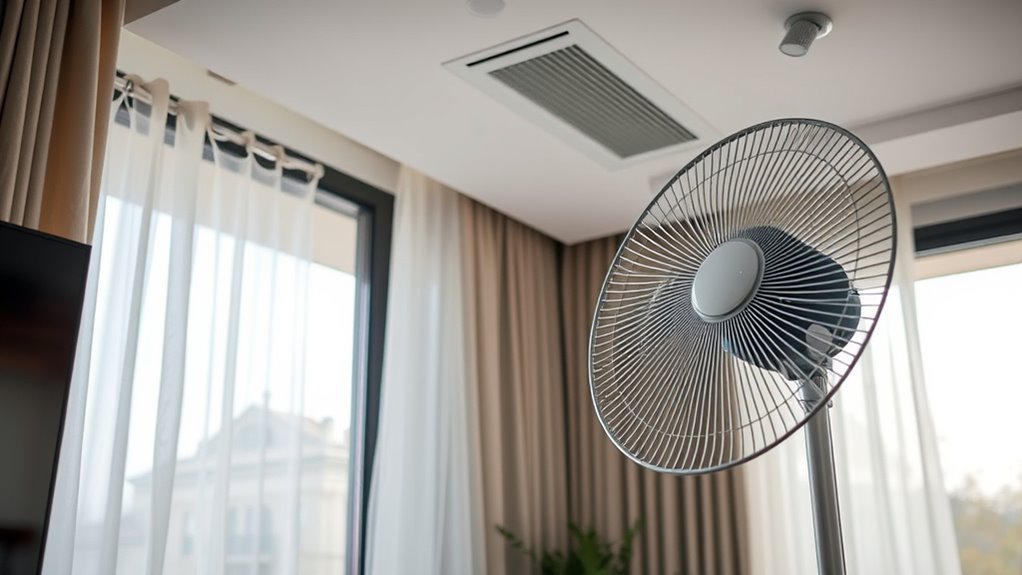
Proper ventilation and airflow are essential for controlling indoor humidity because they help remove excess moisture and prevent stagnation. When you guarantee good airflow, humid air gets replaced with drier air from outside, reducing overall moisture levels. Using exhaust fans in kitchens and bathrooms pulls moist air out before it spreads throughout your home. Opening windows regularly promotes cross-ventilation, which helps maintain balanced humidity. Ceiling fans and air purifiers with airflow features also assist in circulating air evenly, preventing damp spots. Proper ventilation doesn’t just improve comfort; it wards off mold growth and structural damage caused by excess moisture. Remember, stagnant air traps humidity, so consistent airflow keeps your indoor environment dry, fresh, and healthier. Incorporating air quality management strategies can further enhance humidity control and overall indoor comfort.
Preventive Measures to Protect Your Home From Mold and Damage

To effectively protect your home from mold and damage, taking proactive preventive measures is essential. Regularly controlling moisture levels is key—use dehumidifiers or air conditioners to keep humidity below 60%. Seal leaks around windows, doors, and plumbing to prevent water intrusion. Maintain proper ventilation in high-moisture areas like bathrooms and kitchens.
You should also:
- Fix any leaks promptly
- Use mold-resistant paints in damp areas
- Keep gutters clean and drains clear
- Educate yourself about industry trends to stay updated on best practices for humidity control.
These steps help reduce moisture buildup and prevent mold growth before it starts. Consistent maintenance and monitoring are your best defenses against humidity-related issues. Acting early saves you money and preserves your home’s integrity in the long run.
When to Seek Professional Help for Severe Humidity Issues

Severe humidity problems often signal that DIY solutions aren’t enough, and professional intervention is necessary. If you notice persistent mold growth despite your efforts, or if high humidity levels continue despite using dehumidifiers, it’s time to call in experts. Also, if you experience musty odors that won’t go away or notice water stains and structural damage, professionals can diagnose underlying issues. Persistent condensation on windows or walls is another red flag. When humidity issues interfere with your daily life or compromise your home’s safety, get professional help promptly. Qualified specialists can identify hidden sources of moisture, repair leaks, and install advanced ventilation systems to restore balance. Don’t delay—severe humidity problems demand expert intervention to protect your home and health.
Frequently Asked Questions
Can Humidity Problems Cause Long-Term Health Issues?
Yes, humidity problems can cause long-term health issues. When humidity is too high, mold and dust mites thrive, which can trigger allergies, asthma, and respiratory problems. Conversely, low humidity can dry out your skin, throat, and nasal passages, increasing infection risk. Over time, these conditions may weaken your immune system and lead to chronic health issues. Managing indoor humidity levels helps protect your long-term health and creates a healthier living environment.
Are Some Home Materials More Vulnerable to Humidity Damage?
Ever wonder if your home materials are vulnerable to humidity damage? Some materials, like wood, drywall, and paper, are especially susceptible because they absorb moisture, leading to warping, mold, or rot. You should pay close attention to areas prone to humidity, such as basements and bathrooms. By choosing moisture-resistant materials or sealing existing ones, you can protect your home and prevent long-term damage effectively.
How Does Humidity Affect Energy Efficiency in My Home?
High humidity levels make your home less energy-efficient because your AC works harder to cool the air and remove excess moisture. This increased workload raises your energy bills and shortens the lifespan of your HVAC system. To improve efficiency, you should use dehumidifiers, guarantee proper ventilation, and seal leaks. Maintaining ideal humidity levels helps your system operate smoothly, saves you money, and keeps your home more comfortable year-round.
Can Indoor Plants Help Regulate Humidity Levels?
Indoor plants can help regulate humidity levels by absorbing moisture from the air through their leaves and roots. When the air is too dry, plants release moisture through a process called transpiration, which can increase humidity. Conversely, in overly humid environments, they can help absorb excess moisture. Keep in mind, the impact varies with plant size and number, so choose your plants accordingly to maintain balanced humidity.
What Are the Cost Implications of Different Humidity Control Methods?
Controlling humidity can feel like walking a tightrope, but your budget doesn’t have to sway wildly. A simple humidifier costs around $30 to $100, offering quick relief. Dehumidifiers range from $150 to $300, suitable for larger spaces. Ventilation fans are affordable at $50 to $150, while sealing leaks costs varies. Prioritizing your needs guarantees you select a cost-effective method that keeps your indoor air comfy without breaking the bank.
Conclusion
Don’t let hidden humidity problems sneak up on you. By recognizing the signs, monitoring moisture levels, and using simple strategies, you can keep your home comfortable and mold-free. Remember, addressing humidity isn’t just about comfort—it’s about protecting your investment and health. Are you ready to take control of your indoor air quality and create a healthier living space today?









